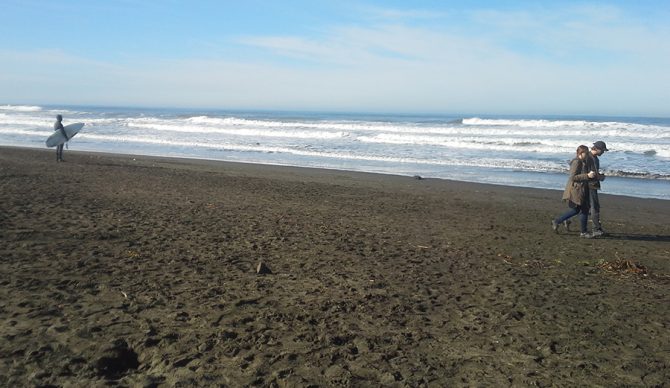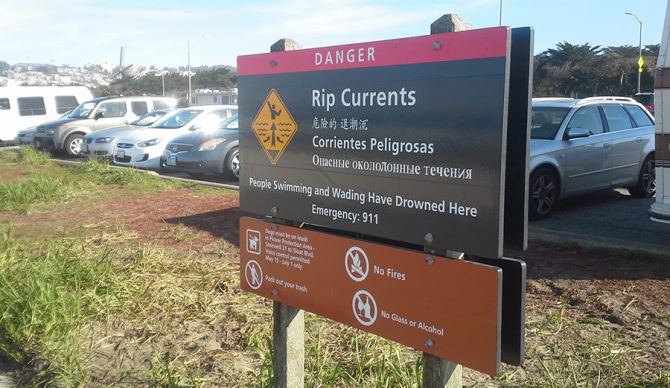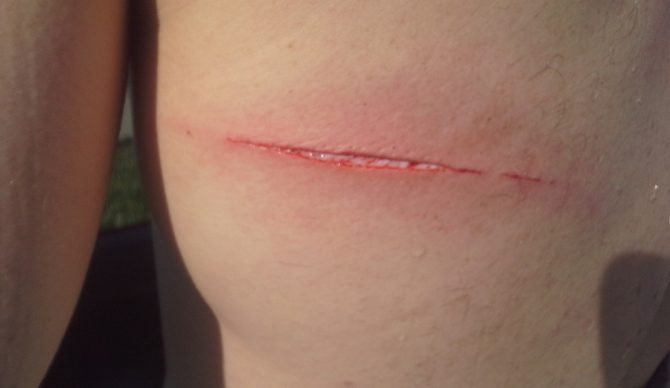
The waves are not as huge as they famously get out here; it’s in the mid-size range, about four to six feet and A-frame peaks span north and south over the long stretch of the beach. Photo Byron Loker
Ocean Beach, San Francisco, February 2017. William Finnegan devoted a few beautiful chapters to the place in his Pulitzer Prize-winning memoir, Barbarian Days: A Surfing Life. “Sometimes, especially on empty, unruly days at San Francisco’s Ocean Beach, my inelegant yet committed surfing could elicit a nod of approval from salty locals. I came close to drowning at Noriega, got washed into the big rock at Kelly’s, got a black eye at Sloat when my board snapped back and hit me square in the face, almost drowned again in the heavy undertow at Montara.”
Surfing OB for the first time myself, the first thing I notice as I pull into the parking lot—apart from the cranking surf—is that a surfer de-suiting two cars away from me has a six inch gash on his back. He seems unperturbed, though, as if he doesn’t notice. “Did someone ride over you?”
“Nah, did it myself, went over the falls and landed on a skeg,” he says. “It’s pretty bad,” I tell him, “probably needs stitches.”
“Stitches? Damnit,” he says, more annoyed about the inconvenience than the injury. “I thought I’d gotten away with it. It split my wetsuit, I thought that was all, though.”
I trade a war story about the 22 skeg-induced stitches I once earned and how I hadn’t felt it at the time—the water numbingly cold, it takes a while before the blood and pain surface.
“I live nearby, I’ll get it cleaned up, have my dad look at it,” the wounded surfer says as if his dad might be in the medical profession. “Thanks, bro.” We part ways and I head down to the water’s edge to get a closer look at the waves.

“I’ve pulled dead guys out of the water here,” my buddy Richard says. Photo Byron Loker
There’s a good run of swell. The waves are not as huge as the stories might have you expecting, though. It’s in the head high range and A-frame peaks span up and down the long stretch of beach.
Later, I meet up with an old high school buddy who has been living and surfing here for the past twenty years. “Meet me at Noriega and Great Highway, on the inside,” he texts me. “Best sand bars!” We meet and drive a minute or two further down the coast to Sloat (the breaks are named for the adjoining streets). Richard loans me a board, some booties, and warns about the currents and how hard the paddle out to the lineup is. “I’ve pulled dead guys out of the water here,” Richard says.
I make the paddle, but I don’t make the take off on my first wave. My board bounces back from the depths, still attached to its leash and agitated by the incredible open-ocean power. It socks me on the right side of the face. I paddle back out sheepishly, touching for blood, expecting it at any moment. Richard paddles over, I ask if it’s bad.
“Looks OK, maybe it’ll bruise,” he says. When it doesn’t bleed after a few minutes, I know it’s fine. Richard has a wave or two. “Woohoo!” He shouts as we share the wave that I’ve dropped in on—a friendly warning that he’s on the inside. We reconvene out back and he asks, “You have travel insurance, right?” I assure him I do. “I had to take my mom for stitches on one visit. She cracked her head on the open door getting into my truck. It cost me four-and-a-half grand.”
A little later a chunky right lines up for me and I don’t commit. I simply don’t paddle hard enough and it goes right by. “What happened on that one, I thought you had it?”
“Ah, I think I chickened out,” I say. “I’m thinking about four-and-a-half grand.”
“It’s only water,” he replies. “Just keep your body away from your board if you fall.”
Later, after coffee and slices of peanut butter honey toast in a hipster haunt and while driving back to my car, we notice that police vehicles have cordoned off the Great Highway from Noriega to Lincoln. There’s a fire truck, lights flashing, and another vehicle emblazoned SURF RESCUE waits where Noriega meets the sand. “Someone must have drowned again,” Richard says. He drops me at my car, we man-hug, make a plan to meet up again soon for another session.

Getting to surf OB for the first time, the first thing I notice as I pull into the parking lot—apart from the cooking surf—is that a surfer de-suiting two cars away from me has a 6-inch gash in his back. Photo Byron Loker

